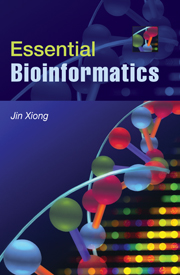Book contents
- Frontmatter
- Contents
- Preface
- SECTION I INTRODUCTION AND BIOLOGICAL DATABASES
- SECTION II SEQUENCE ALIGNMENT
- SECTION III GENE AND PROMOTER PREDICTION
- SECTION IV MOLECULAR PHYLOGENETICS
- SECTION V STRUCTURAL BIOINFORMATICS
- SECTION V GENOMICS AND PROTEOMICS
- 17 Genome Mapping, Assembly, and Comparison
- 18 Functional Genomics
- 19 Proteomics
- APPENDIX
- Index
- Plate section
- References
19 - Proteomics
Published online by Cambridge University Press: 05 June 2012
- Frontmatter
- Contents
- Preface
- SECTION I INTRODUCTION AND BIOLOGICAL DATABASES
- SECTION II SEQUENCE ALIGNMENT
- SECTION III GENE AND PROMOTER PREDICTION
- SECTION IV MOLECULAR PHYLOGENETICS
- SECTION V STRUCTURAL BIOINFORMATICS
- SECTION V GENOMICS AND PROTEOMICS
- 17 Genome Mapping, Assembly, and Comparison
- 18 Functional Genomics
- 19 Proteomics
- APPENDIX
- Index
- Plate section
- References
Summary
Proteome refers to the entire set of expressed proteins in a cell. In other words, it is the full complement of translated product of a genome. Proteomics is simply the study of the proteome. More specifically, it involves simultaneous analyses of all translated proteins in a cell. It encompasses a range of activities including large-scale identification and quantification of proteins and determination of their localization, modifications, interactions, and functions. This chapter covers the major topics in proteomics such as analysis of protein expression, posttranslational modifications, protein sorting, and protein–protein interaction with an emphasis on bioinformatics applications.
Compared to transcriptional profiling in functional genomics, proteomics has clear advantages in elucidating gene functions. It provides a more direct approach to understanding cellular functions because most of the gene functions are realized by proteins. Transcriptome analysis alone does not provide clear answers to cellular functions because there is generally not a one-to-one correlation between messenger RNAs (mRNAs) and proteins in the cells. In addition, a gene in an eukaryotic genome may produce more varied translational products owing to alternative splicing, RNA editing, and so on. This means that multiple and distinct proteins may be produced from one single gene. Further complexities of protein functions can be found in posttranslational modifications, protein targeting, and protein–protein interactions. Therefore, the noncorrelation of mRNA with proteins means that studying protein expression can provide more insight on understanding of gene functions.
- Type
- Chapter
- Information
- Essential Bioinformatics , pp. 281 - 298Publisher: Cambridge University PressPrint publication year: 2006



